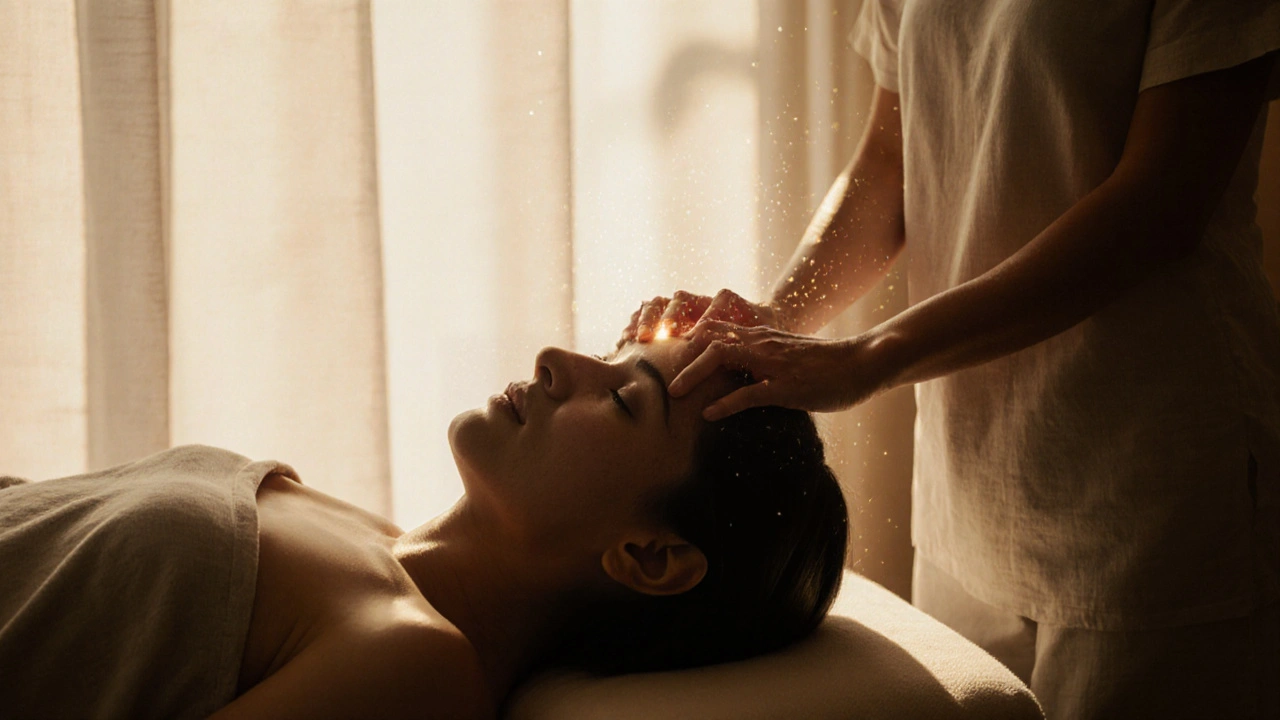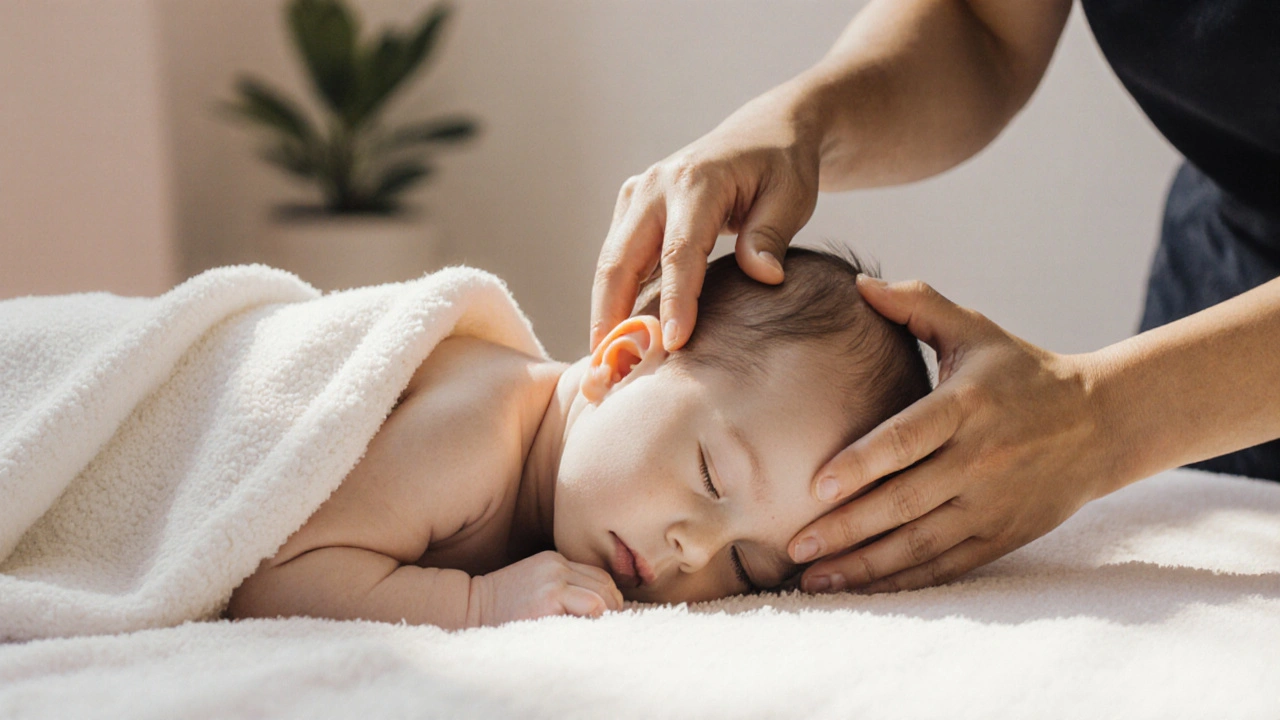Unveiling the Mysteries of Craniosacral Therapy: What It Really Does and Who It Helps

- Nov, 18 2025
- 0 Comments
- Joshua Snowden
Craniosacral Therapy Symptom Assessment Tool
How Can CST Help You?
This assessment helps determine if craniosacral therapy might be beneficial for your specific concerns. Note: CST is not a medical treatment or substitute for professional healthcare.
Your Assessment
Imagine a therapy that doesn’t involve needles, drugs, or deep pressure - just the lightest touch, like holding a feather, and yet claims to unlock deep healing in your body. That’s craniosacral therapy. It sounds strange. Maybe even a little woo-woo. But millions of people have tried it, and many swear it changed their lives. So what’s really going on?
What Is Craniosacral Therapy?
Craniosacral therapy, or CST, is a gentle, hands-on technique that focuses on the bones of the skull (cranium), the spine, and the sacrum - the triangular bone at the base of your spine. Practitioners believe that these areas are connected by a system of membranes and fluid called the craniosacral system. This system surrounds and protects your brain and spinal cord, and it’s filled with cerebrospinal fluid - the same fluid that cushions your nervous system.
The theory goes that this fluid moves in a rhythmic pattern, like a slow tide. When stress, injury, or trauma happens - even from birth - this rhythm can get stuck or slowed down. CST practitioners use their hands, often with less than five grams of pressure (about the weight of a nickel), to feel for these restrictions and help the fluid flow again.
It’s not massage. It’s not chiropractic. It’s not acupuncture. It’s its own thing. And it’s been around since the 1930s, when osteopath John Upledger developed it from earlier work by William Sutherland. He noticed that the bones of the skull weren’t fused like everyone thought. They moved slightly. That movement, he believed, was tied to the rhythm of cerebrospinal fluid.
What Happens During a Session?
You lie fully clothed on a massage table. The practitioner places their hands gently on your head, neck, feet, or spine. That’s it. No cracking. No twisting. No deep tissue work. Some people feel warmth, tingling, or a subtle pulsing. Others feel nothing at all. And that’s okay.
Sessions usually last 45 to 60 minutes. People often fall asleep. Some cry. Others feel deeply relaxed - like they’ve been on vacation for a week. Afterward, you might feel lighter, calmer, or even a little dizzy. That’s normal. The body is adjusting.
Most people need a series of 4 to 8 sessions. One session rarely fixes everything. Like physical therapy or acupuncture, results build over time. Some clients come weekly. Others come monthly, just to stay balanced.
Who Uses Craniosacral Therapy?
You might think CST is only for people chasing alternative healing. But it’s used by all kinds of folks.
- People with chronic headaches or migraines: Many report fewer and less intense headaches after CST. A 2018 pilot study in the Journal of Bodywork and Movement Therapies found that 70% of participants with chronic migraines saw improvement after six sessions.
- Those recovering from trauma: CST is often used alongside counseling for people with PTSD. The gentle touch helps the nervous system reset without triggering fight-or-flight responses.
- Babies and infants: Pediatric CST is common for colic, feeding difficulties, or birth trauma. Practitioners use even lighter pressure - sometimes just the weight of a fingertip - to help babies release tension from delivery.
- People with fibromyalgia or chronic fatigue: Many report better sleep and less pain. While it doesn’t cure these conditions, it often helps manage symptoms.
- Stress-sensitive individuals: If deep tissue massage feels overwhelming, CST offers a quiet, non-invasive alternative.
What Does Science Say?
Here’s the tough part: science doesn’t fully back up the theory behind CST.
The idea that cranial bones move significantly in adults? That’s been challenged. Most anatomists say the sutures between skull bones fuse solidly after childhood. The existence of a measurable craniosacral rhythm? No peer-reviewed study using reliable instruments has confirmed it. The fluid’s movement is too small to detect with current tools.
So why do people feel better?
Some experts think the benefits come from the nervous system calming down. The gentle touch triggers the parasympathetic nervous system - your body’s rest-and-digest mode. That lowers cortisol, slows heart rate, and reduces muscle tension. Even if the fluid rhythm isn’t real, the relaxation response is.
Other researchers suggest it’s a form of therapeutic touch - the power of focused attention and human connection. In a world full of noise and pressure, being held gently for an hour is healing in itself.
That doesn’t make CST fake. It just means the explanation might be simpler than the theory.

Who Should Avoid It?
CST is generally safe. But it’s not for everyone.
- People with recent head injuries: If you’ve had a concussion, skull fracture, or brain bleed in the last 6 weeks, avoid CST until cleared by a doctor.
- Those with aneurysms or severe vascular conditions: Even light pressure could theoretically affect blood flow in rare cases.
- People expecting a medical cure: CST won’t reverse cancer, fix a herniated disc, or cure diabetes. It’s not a replacement for medical care.
If you’re unsure, talk to your doctor first. Especially if you’re pregnant, have a pacemaker, or are on blood thinners.
How to Find a Good Practitioner
Anyone can call themselves a craniosacral therapist. But not everyone has the training.
Look for someone certified by one of these organizations:
- Upledger Institute International
- Craniosacral Therapy Association
- Biodynamic Craniosacral Therapy Association
Ask about their training hours. Reputable practitioners have at least 70 hours of hands-on training, plus supervised practice. Some have 500+ hours. Don’t be afraid to ask for credentials.
Also, trust your gut. If the practitioner pushes you to buy a package of 20 sessions upfront, walks out of the room while you’re undressing, or talks in mystical jargon without explaining what they’re doing - walk away.
What to Expect After Your First Session
Some people feel amazing right away. Others feel worse before they feel better. That’s called a healing reaction. Your body is releasing stored tension. You might feel tired, emotional, or even have a mild headache. That usually passes in 24 to 48 hours.
Keep a journal. Note how you sleep, your pain levels, your mood. Many people report improvements in:
- Sleep quality
- Stress tolerance
- Neck and back tension
- Focus and mental clarity
- Emotional regulation
These changes are often subtle. They don’t show up on an MRI. But they show up in your life.

How CST Compares to Other Therapies
| Therapy | Pressure Level | Focus Area | Typical Session Length | Best For |
|---|---|---|---|---|
| Craniosacral Therapy | Light (5 grams) | Skull, spine, sacrum | 45-60 min | Nervous system reset, trauma release |
| Reiki | None (hands hover) | Energy fields | 30-60 min | Stress, emotional balance |
| Myofascial Release | Moderate to firm | Connective tissue | 60 min | Chronic muscle tightness |
| Massage Therapy | Varies | Muscles, soft tissue | 30-90 min | Relaxation, soreness relief |
CST stands out because of its extreme gentleness. It doesn’t try to fix muscles. It tries to calm the system that controls them.
Is It Worth Trying?
If you’ve tried everything else and still feel off - tight, anxious, tired, or stuck - CST might be worth a try. It’s low-risk. No drugs. No side effects. Just quiet touch.
It’s not magic. It’s not a miracle cure. But for some, it’s the missing piece.
One woman came to CST after years of migraines and insomnia. She’d tried medications, acupuncture, yoga. Nothing stuck. After four CST sessions, she started sleeping through the night. Her headaches dropped from daily to once a month. She didn’t know why. She just knew she felt like herself again.
That’s the mystery. And maybe that’s the point.
Does craniosacral therapy really move bones in the skull?
Most anatomists say adult skull bones are fused and don’t move significantly. But CST practitioners aren’t trying to push bones around - they’re feeling for subtle rhythms in fluid and tissue. Whether the rhythm exists or not, many people still benefit from the relaxation response.
Can craniosacral therapy help with anxiety?
Yes. Many clients report reduced anxiety after CST. The gentle touch activates the parasympathetic nervous system, which lowers stress hormones like cortisol. It’s not a replacement for therapy or medication, but it can be a helpful complement.
Is craniosacral therapy covered by insurance?
Rarely. Most insurance plans don’t cover CST because it’s considered alternative therapy. Some flexible spending accounts (FSAs) or health savings accounts (HSAs) might allow it if you have a letter from your doctor. Always check with your provider.
How long does it take to see results from CST?
Some feel changes after one session - usually deeper relaxation or better sleep. For chronic issues like migraines or trauma, most people need 4 to 8 sessions. Results build slowly, like physical therapy.
Can babies and children receive craniosacral therapy?
Yes. Pediatric CST is common and very gentle. It’s often used for colic, breastfeeding difficulties, sleep issues, or birth trauma. Practitioners use fingertip pressure - lighter than a feather - and sessions are shorter, usually 20 to 30 minutes.
Next Steps If You’re Curious
Start with one session. Don’t commit to a package. Find a certified practitioner. Tell them your goals - whether it’s better sleep, less neck pain, or just calming your nervous system. Keep notes afterward. If you feel better, keep going. If not, you’ve spent an hour relaxing and learned something new.
Craniosacral therapy doesn’t promise miracles. But for those who’ve tried everything else, it sometimes offers something rare: quiet relief.